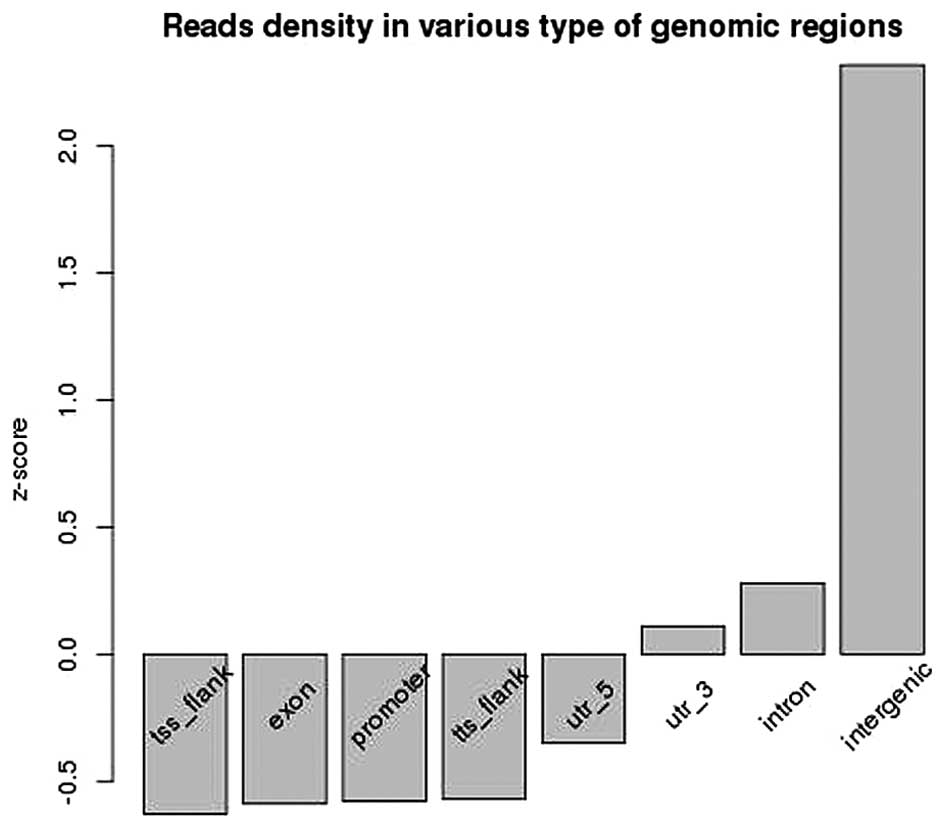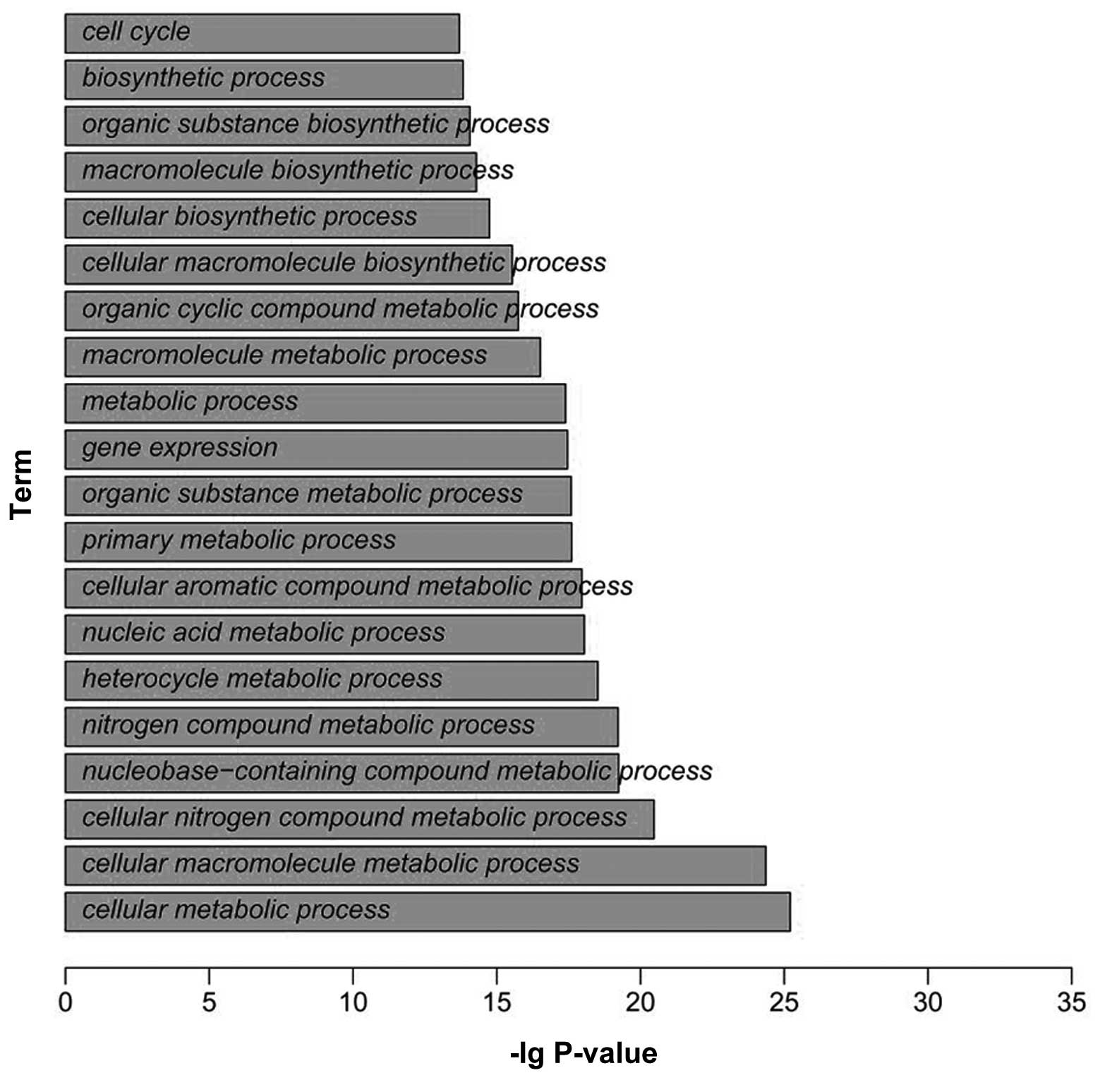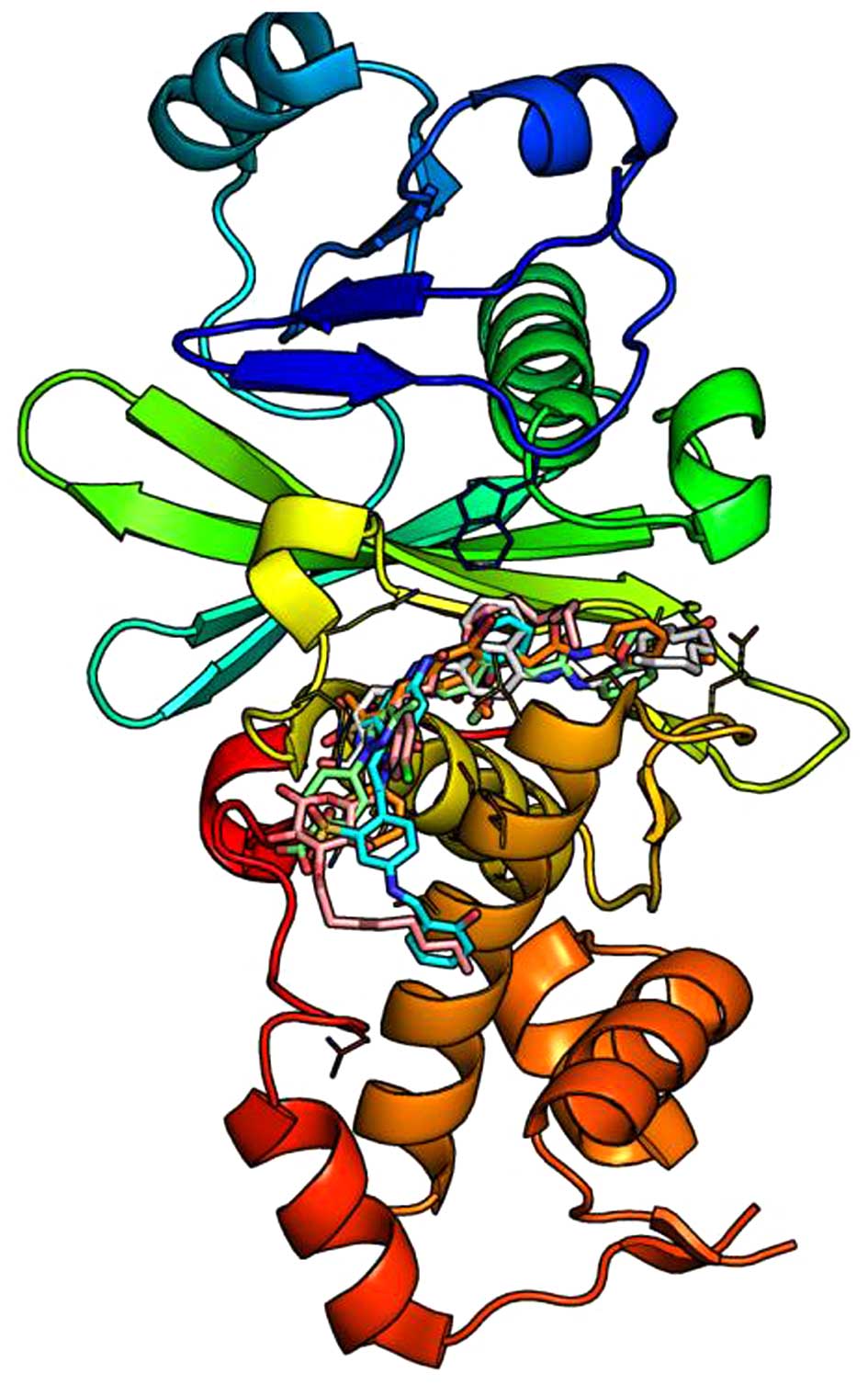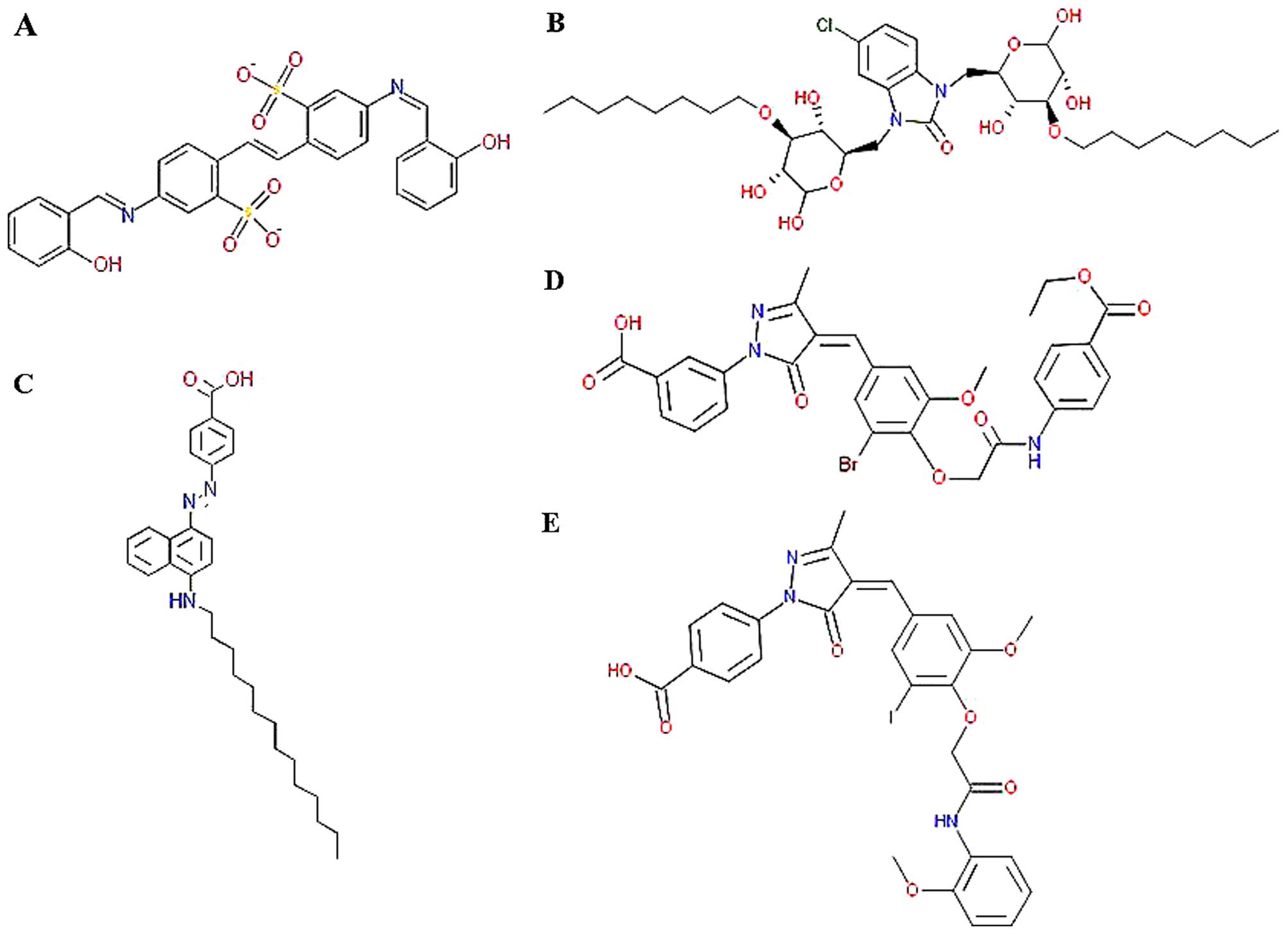Functional analysis of HBO1 in tumor development and inhibitor screening
- Authors:
- Published online on: May 31, 2016 https://doi.org/10.3892/ijmm.2016.2617
- Pages: 300-304
Abstract
Introduction
Histone modifications, including acetylation, methylation and phosphorylation have been demonstrated to play critical roles in gene-specific transcriptional regulation, DNA replication, DNA damage response and repair (1,2). Acetylation, as the earliest identified histone modification, involves the transfer of an acetyl group from acetyl-CoA to the e-amino group of lysine residue by histone acetyltransferases (HATs) (3).
Histone acetyltransferase binding to origin recognition complex (ORC) 1 (HBO1), belonging to the MYST family, was discovered in the context of DNA replication (3). HBO1, as an H4-specific histone acetylase, can interact with transcription factors (4), mRNA coding regions (5) and ORC (6). Researches have demonstrated that HBO1 is necessary for licensing and DNA replication (7) and that it is associated with replication origins specifically during the G1 phase of the cell cycle (8). Considering the critical role of HBO1 in DNA replication, it has been demonstrated that HBO1 mutations can lead to profound negative consequences, and even to oncogenesis (3). On the one hand, the HBO1 coding region was identified to be a common retroviral integration site (9). As infections with some viruses are considered to lead to oncogenesis, HBO1 may indirectly contribute to the induction of cancer (10). On the other hand, the binding partners of HBO1 are considered to be related to diseases. The interaction of HBO1 with androgen receptor was putatively linked to prostate cancer development (11) and the interaction of HBO1 with nuclear factor κ-light-chain-enhancer of activated B cells (NF-κB) was connected with tumor suppression (12). Hence, HBO1 is critical in the development of tumors, although the mechanisms involved remain unclear.
In the present study, the possible binding sites of HBO1 on all chromosomes were explored based on chromatin immunoprecipitation sequencing (ChIP-seq) analysis. To explore the regulatory mechanisms of HBO1 during tumor development, the genes that can be regulated putatively by HBO1 were subjected to functional enrichment analysis. Furthermore, the structure and inhibitors of HBO1 were systematically explored, which may prove to be helpful for the discovery of novel anticancer drugs.
Data collection methods
ChIP-seq data of HBO1 in the RKO human colon cancer cell line
The ChIP-seq data [GSE33007 (13)] were downloaded from the Gene Expression Omnibus (GEO) (14) database (http://www.ncbi.nlm.nih.gov/geo/). The data included two samples: one was obtained in the RKO colon cancer cell line and the other one was obtained in a normal cell line. The samples were sequenced on the Illumina Genome Analyzer IIx platform.
Analysis of ChIP-seq data
The reads were mapped back to a reference genome hg19 from the University of California, Santa Cruz (UCSC) Genome Browser (15) by using Bowtie software (16) (version 0.12.9). The reads were screened out for subsequent analysis with the criteria of unique alignment position and a mismatch number <2. The PCR duplicate reads were then removed using SAMtools (17) to keep at most one read per genomic position. The shifts of 5′ and 3′ are defined as a half of the average size of the ChIP-seq fragments for the experimental and control groups using SPP and MaSC software. The peak calling was carried out using MACS 1.4.0 software (18). The reads with a P-value >0.00001 were considered as the HBO1 binding sites.
Gene functional analysis
The target genes of HBO1 were identified using the ChIPpeakAnno (19) package within R. The functions of those genes were subjected to functional enrichment analysis based on the Gene Ontology (GO) database (http://www.geneontology.org/) using the getEnrichedGO module within the ChIPpeakAnno package (19). The criteria were set to a P-value <2e-14.
HBO1 structure analysis and inhibitor screening
The 3D structure of HBO1 (PDB ID: 2pq8) was downloaded from Protein Data Bank (PDB; http://www.rcsb.org/pdb/home/home.do) and the coenzyme binding site analysis and structure visualization were conducted using PyMOL software (20). The virtual screening of inhibitors was carried out using DOCK 6.6 software (21) following structure preprocessing with Chimera software (22). The force field was set to Amber99sb and the binding sites were set to be within 6 Å around the coenzyme. The Specs compound database was used for the screening and the top 5 compounds with best binding affinity were screened out and analyzed.
Results
HBO1 binding sites
Based on the ChIP-seq analysis, the enriched positions of HBO1 binding sites were mainly distributed in the intergenic, intron and 3′-end regions (Fig. 1).
Identification and functional analysis HBO1 target genes
To explore the regulatory mechanism of HOB1, the HBO1 target genes were identified and subjected to functional enrichment analysis. A total of 9,467 target genes was identified around HBO1 binding sites in the RKO cell line. Functional enrichment analysis revealed that the genes were mainly enriched in the functions of cell cycle, biosynthetic process, organic substance biosynthetic process and macromolecule biosynthetic process (Fig. 2).
HBO1 structure analysis
HBO1 combined with an acetyl-CoA belongs to the HATs family. The surface of HBO1 was covered by charged residues and the acetyl-CoA was located at a cavity which was full of positively charged residues (Fig. 3). The entrance of the cavity was guarded by a positively charged side chain of R325, promoting the binding of negatively charged compounds.
HBO1 inhibitor screening
Based on the HBO1 3D structure and acetyl-CoA binding site, the inhibitors of HBO1 were screened out from the Specs database. As shown in Fig. 4, a total of 5 compounds with best binding affinity in the cavity were screened out: i) 5-[(2-hydroxybenzylidene)amino]-2-(2-{4-[(2-hydroxybenzylidene)amino]-2-sulfonatophenyl}vinyl)benzenesulfonate, ii) 3-[4-(3-bromo-4-{2-[4-(ethoxycarbonyl)anilino]-2-oxoethoxy}-5-methoxybenzylidene)-3-methyl-5-oxo-4,5-dihydro-1H-pyrazol-1-yl]benzoic acid, iii) 4-(4-{3-iodo-5-methoxy-4-[2-(2-methoxyanilino)-2-oxoethoxy]benzylidene}-3-methyl-5-oxo-4,5-dihydro-1H-pyrazol-1-yl)benzoic acid, iv) 5-chloro-1,3-bis{[3,5,6-trihy-droxy-4-(octyloxy)tetrahydro-2H-pyran-2-yl]methyl}-1,3-dihydro-2H-benzimidazol-2-one and v) 4-{[4-(tetradecylamino)-1-naphthyl]diazenyl}benzoic acid. The structures of the 5 compounds are depicted in Fig. 5 and the corresponding Specs IDs are AO-861/15351016, AO-763/14815006, AA-516/33241036, AK-968/13031190 and AK-968/13031237, respectively.
Discussion
HBO1 has been demonstrated play critical roles in genome expression and maintenance (3). In this study, we explored the possible binding sites of HBO1 on all chromosomes. By focusing our efforts on the functions of HBO1, the genes that can be regulated by HBO1 were identified and subjected to functional analysis. Furthermore, the coenzyme binding site and surface charge distribution of HBO1 were explored and the potential inhibitors were screened out.
Based on the results of ChIP-seq analysis, HBO1 mainly binds upstream of gene transcription start sites and putatively enhances gene expression. Experiments have indicated that a strong enrichment of HOB1 near the homeobox A9 (HOXA9) and homeobox A10 (HOXA10) genes and the expression of HOXA10 is found to be downregulated upon the knockdown of HBO1 (13). ChIP analysis has also revealed that HBO1 is highly enriched throughout the coding regions of a large number of human genes, from the middle of the genes to the transcription end sites or centered around the transcription start sites (5). The critical role of HBO1 in gene transcriptional regulation implies that HBO1 probably participates in the regulation of tumor development.
The target genes of HBO1 were significantly related to the cell cycle process, based on functionalo enrichment analysis. The association of HBO1 with various inhibitor of growth (ING) tumor suppressor proteins suggests that it plays critical roles in gene regulation and DNA replication through histone H3 and H4 acetylation (13). Genomic analysis has indicated that the HBO1 and ING complexes are mainly involved in the regulation of the p53 pathways (13). Histone acetylase defective mutant experiments have also demonstrated that HBO1 acetylase activity is necessary for replication licensing. HOB1 can regulate the expression of cell division cycle 27 (CDC27), cyclin-dependent kinase inhibitor 2D (CDKN2D) and cell division cycle 20 (CDC20), which can participate in cell cycle progression. The protein encoded by CDC27 is a component of anaphase-promoting complex (APC) (23). Experiments have shown that the interaction between this protein and mitotic checkpoint proteins, such as mitotic arrest deficient 2 (Mad2), p55 cell-division cycle protein 20 (p55CDC) and BUB1 mitotic checkpoint serine/threonine kinase B (BUBR1) are involved in controlling the timing of mitosis (24). The protein encoded by CDKN2D can suppress the activation of the CDK kinases and regulate cell cycle G1 progression by forming a stable complex with CDK4 or CDK6 (25). Similarly, CDC20 was demonstrated to be a regulatory protein at multiple cell cycle points by interacting with several other proteins (26). CDC20 can bind to and promote the ubiquitin ligase activity of anaphase-promoting complex/cyclosome (APC/C) and enable the degradation of securing and cyclin B, thus promoting the onset of anaphase and mitotic exit (27). All these data demonstrate the importance of HBO1 in controlling cell proliferation and in the regulation of cell cycle.
Structure analysis indicated that the acetyl-CoA combined with HBO1 in the cavity was surrounded with positively charged residues. The acetyl-CoA binds in a bent conformation which facilitates an extensive set of protein interactions. In addition, the positively charged side chain of R325 in the cavity entrance promotes the binding of negatively charged substrates. The potential inhibitors can combine with HBO1 perfectly in the cavity. The inhibitors possess various polar groups, such as carbonyl oxygen, hydroxyl oxygen and heterocyclic nitrogen, which can mediate interactions between HBO1 and inhibitors by protein backbone hydrogen bonds or protein side chain van der Waals interactions. Hence, the inhibition of HBO1 can interrupt the cell cycle or cell proliferation and putatively suppress tumor development.
In conclusion, in this study, the location and target gene function alanalysis of HBO1 indicated that HBO1 plays critical roles in the regulation of gene expression and the cell cycle. Furthermore, structure analysis and inhibitor identification provided the HBO1 regulatory mechanisms, which may prove to be helpful for the inhibition of tumor development.
References
|
Karlić R, Chung H-R, Lasserre J, Vlahoviček K and Vingron M: Histone modification levels are predictive for gene expression. Proc Natl Acad Sci USA. 107:2926–2931. 2010. View Article : Google Scholar | |
|
Henikoff S and Shilatifard A: Histone modification: Cause or cog? Trends Genet. 27:389–396. 2011. View Article : Google Scholar : PubMed/NCBI | |
|
Avvakumov N and Côté J: The MYST family of histone acetyltransferases and their intimate links to cancer. Oncogene. 26:5395–5407. 2007. View Article : Google Scholar : PubMed/NCBI | |
|
Georgiakaki M, Chabbert-Buffet N, Dasen B, Meduri G, Wenk S, Rajhi L, Amazit L, Chauchereau A, Burger CW, Blok LJ, et al: Ligand-controlled interaction of histone acetyltransferase binding to ORC-1 (HBO1) with the N-terminal transactivating domain of progesterone receptor induces steroid receptor coactivator 1-dependent coactivation of transcription. Mol Endocrinol. 20:2122–2140. 2006. View Article : Google Scholar : PubMed/NCBI | |
|
Saksouk N, Avvakumov N, Champagne KS, Hung T, Doyon Y, Cayrou C, Paquet E, Ullah M, Landry AJ, Côté V, et al: HBO1 HAT complexes target chromatin throughout gene coding regions via multiple PHD finger interactions with histone H3 tail. Mol Cell. 33:257–265. 2009. View Article : Google Scholar : PubMed/NCBI | |
|
Burke TW, Cook JG, Asano M and Nevins JR: Replication factors MCM2 and ORC1 interact with the histone acetyltransferase HBO1. J Biol Chem. 276:15397–15408. 2001. View Article : Google Scholar : PubMed/NCBI | |
|
Doyon Y, Cayrou C, Ullah M, Landry AJ, Côté V, Selleck W, Lane WS, Tan S, Yang XJ and Côté J: ING tumor suppressor proteins are critical regulators of chromatin acetylation required for genome expression and perpetuation. Mol Cell. 21:51–64. 2006. View Article : Google Scholar : PubMed/NCBI | |
|
Miotto B and Struhl K: HBO1 histone acetylase is a coactivator of the replication licensing factor Cdt1. Genes Dev. 22:2633–2638. 2008. View Article : Google Scholar : PubMed/NCBI | |
|
Suzuki T, Shen H, Akagi K, Morse HC, Malley JD, Naiman DQ, Jenkins NA and Copeland NG: New genes involved in cancer identified by retroviral tagging. Nat Genet. 32:166–174. 2002. View Article : Google Scholar : PubMed/NCBI | |
|
Iizuka M, Takahashi Y, Mizzen CA, Cook RG, Fujita M, Allis CD, Frierson HF Jr, Fukusato T and Smith MM: Histone acetyltransferase Hbo1: Catalytic activity, cellular abundance, and links to primary cancers. Gene. 436:108–114. 2009. View Article : Google Scholar : PubMed/NCBI | |
|
Sharma M, Zarnegar M, Li X, Lim B and Sun Z: Androgen receptor interacts with a novel MYST protein, HBO1. J Biol Chem. 275:35200–35208. 2000. View Article : Google Scholar : PubMed/NCBI | |
|
Contzler R, Regamey A, Favre B, Roger T, Hohl D and Huber M: Histone acetyltransferase HBO1 inhibits NF-kappaB activity by coactivator sequestration. Biochem Biophys Res Commun. 350:208–213. 2006. View Article : Google Scholar : PubMed/NCBI | |
|
Avvakumov N, Lalonde M-E, Saksouk N, Paquet E, Glass KC, Landry AJ, Doyon Y, Cayrou C, Robitaille GA, Richard DE, et al: Conserved molecular interactions within the HBO1 acetyltransferase complexes regulate cell proliferation. Mol Cell Biol. 32:689–703. 2012. View Article : Google Scholar : | |
|
Barrett T, Troup DB, Wilhite SE, Ledoux P, Rudnev D, Evangelista C, Kim IF, Soboleva A, Tomashevsky M, Marshall KA, et al: NCBI GEO: Archive for high-throughput functional genomic data. Nucleic Acids Res. 37(Database): D885–D890. 2009. View Article : Google Scholar : | |
|
Fujita PA, Rhead B, Zweig AS, Hinrichs AS, Karolchik D, Cline MS, Goldman M, Barber GP, Clawson H, Coelho A, et al: The UCSC Genome Browser database: Update 2011. Nucleic Acids Res. 39(Database): D876–D882. 2011. View Article : Google Scholar : | |
|
Langmead B, Trapnell C, Pop M and Salzberg SL: Ultrafast and memory-efficient alignment of short DNA sequences to the human genome. Genome Biol. 10:R252009. View Article : Google Scholar : PubMed/NCBI | |
|
Li H, Handsaker B, Wysoker A, Fennell T, Ruan J, Homer N, Marth G, Abecasis G and Durbin R: 1000 Genome Project Data Processing Subgroup: The sequence alignment/map format and SAMtools. Bioinformatics. 25:2078–2079. 2009. View Article : Google Scholar : PubMed/NCBI | |
|
Zhang Y, Liu T, Meyer CA, Eeckhoute J, Johnson DS, Bernstein BE, Nusbaum C, Myers RM, Brown M, Li W and Liu XS: Model-based analysis of ChIP-Seq (MACS). Genome Biol. 9:R1372008. View Article : Google Scholar : PubMed/NCBI | |
|
Zhu LJ, Gazin C, Lawson ND, Pagès H, Lin SM, Lapointe DS and Green MR: ChIPpeakAnno: a bioconductor package to annotate ChIP-seq and ChIP-chip data. BMC Bioinformatics. 11:2372010. View Article : Google Scholar : PubMed/NCBI | |
|
DeLano WL: The PyMOL Molecular Graphics System DeLano Scientific. San Carlos, CA, USA: 2002, http://www.pymol.org. | |
|
Lang PT, Brozell SR, Mukherjee S, Pettersen EF, Meng EC, Thomas V, Rizzo RC, Case DA, James TL and Kuntz ID: DOCK 6: combining techniques to model RNA-small molecule complexes. RNA. 15:1219–1230. 2009. View Article : Google Scholar : PubMed/NCBI | |
|
Pettersen EF, Goddard TD, Huang CC, Couch GS, Greenblatt DM, Meng EC and Ferrin TE: UCSF Chimera - a visualization system for exploratory research and analysis. J Comput Chem. 25:1605–1612. 2004. View Article : Google Scholar : PubMed/NCBI | |
|
Topper LM, Campbell MS, Tugendreich S, Daum JR, Burke DJ, Hieter P and Gorbsky GJ: The dephosphorylated form of the anaphase-promoting complex protein Cdc27/Apc3 concentrates on kinetochores and chromosome arms in mitosis. Cell Cycle. 1:282–292. 2002. View Article : Google Scholar : PubMed/NCBI | |
|
Singh N, Wiltshire TD, Thompson JR, Mer G and Couch FJ: Molecular basis for the association of microcephalin (MCPH1) protein with the cell division cycle protein 27 (Cdc27) subunit of the anaphase-promoting complex. J Biol Chem. 287:2854–2862. 2012. View Article : Google Scholar : | |
|
Carcagno AL, Marazita MC, Ogara MF, Ceruti JM, Sonzogni SV, Scassa ME, Giono LE and Cánepa ET: E2F1-mediated upregulation of p19INK4d determines its periodic expression during cell cycle and regulates cellular proliferation. PLoS One. 6:e219382011. View Article : Google Scholar : PubMed/NCBI | |
|
Hadjihannas MV, Bernkopf DB, Brückner M and Behrens J: Cell cycle control of Wnt/β-catenin signalling by conductin/axin2 through CDC20. EMBO Rep. 13:347–354. 2012. View Article : Google Scholar : PubMed/NCBI | |
|
Yu H: Cdc20: A WD40 activator for a cell cycle degradation machine. Mol Cell. 27:3–16. 2007. View Article : Google Scholar : PubMed/NCBI |














